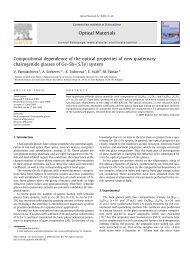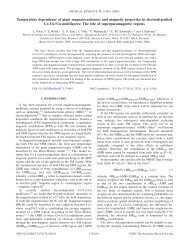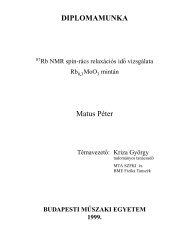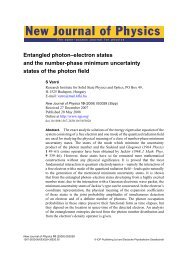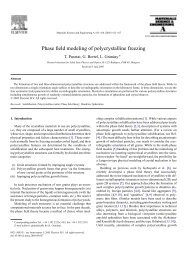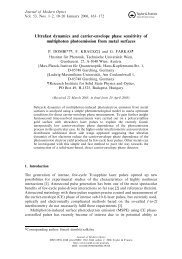ANNUAL REPORT - MTA SzFKI
ANNUAL REPORT - MTA SzFKI
ANNUAL REPORT - MTA SzFKI
Create successful ePaper yourself
Turn your PDF publications into a flip-book with our unique Google optimized e-Paper software.
Fig. 1. ns-EC to s-EC transition induced (a) by increase of the temperature T (polarizing microscopy); (b) by<br />
increase of the voltage U (light diffraction fringes). n denotes the initial director.<br />
Interactions at liquid crystal surfaces. — Experiments on director gliding have been<br />
carried out on Arabic gum and glucose layers. On Arabic gum flow alignment has been<br />
detected with permanent director orientation, while on glucose layers gliding has been<br />
found, which has speeded up above the glass-transition temperature of the glucose (32 o C).<br />
According to the first measurements, the distribution of relaxation times of the gliding<br />
process is much narrower for glucose than on corresponding polymer layers.<br />
Granular flow. — The flow properties of a granular layer of thickness h on an inclined<br />
plane (inclination angle θ) can be characterized by the so called flow rule, which describes<br />
the thickness dependence of the surface velocity u. The flow rule of granular flows on a<br />
rough inclined plane has been measured for various materials, including sand and glass<br />
beads of various sizes and four types of copper particles with different shapes. The<br />
materials have been characterized by measuring h s , the thickness at which the flow stops,<br />
as a function of the plane inclination on various surfaces. Measuring the surface velocity u<br />
of the gravity induced flow as a function of the flow thickness h, deviations from the<br />
Pouliquen flow rule u/(gh) 0.5 ~h/h s have been detected for sand and glass beads. An<br />
improved collapse of the experimental data has been obtained by using a recently proposed<br />
scaling of the form u/(gh) 0.5 =β htan 2 θ/h s tan 2 θ 1 where θ 1 is the angle at which the h s curves<br />
diverge. Measuring the slope β for ten different sizes of sand and glass beads, we find a<br />
systematic, strong increase of β with the divergence angle θ 1 . Copper materials with<br />
different shapes could not well be described by either flow rule.<br />
E-Mail:<br />
Tamás Börzsönyi btamas@szfki.hu<br />
Ágnes Buka ab@szfki.hu<br />
Nándor Éber eber@szfki.hu<br />
Katalin Fodor-Csorba fodor@szfki.hu<br />
István Jánossy janossy@szfki.hu<br />
Tibor Tóth-Katona katona@szfki.hu<br />
Anikó Vajda vajda@szfki.hu<br />
30





